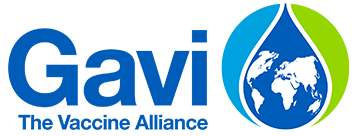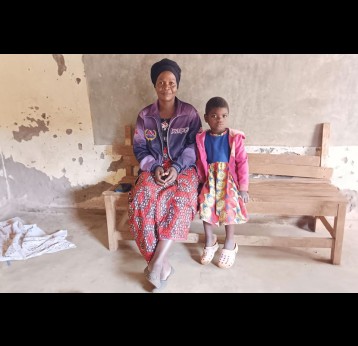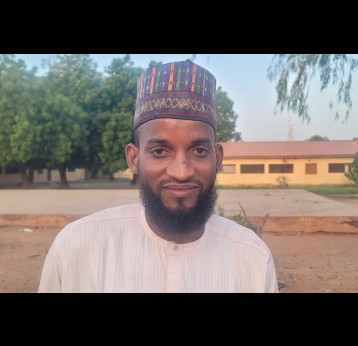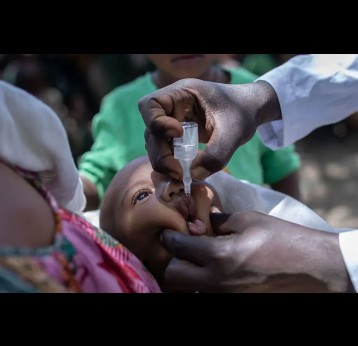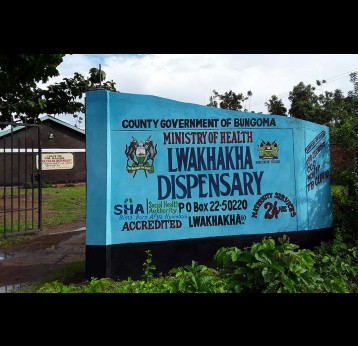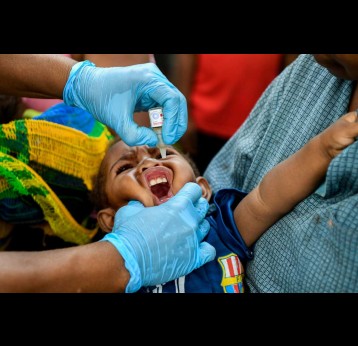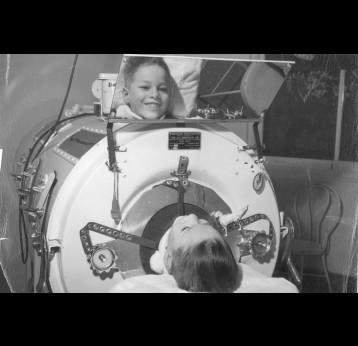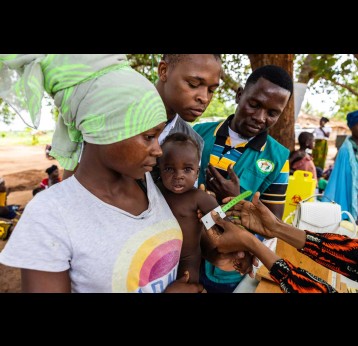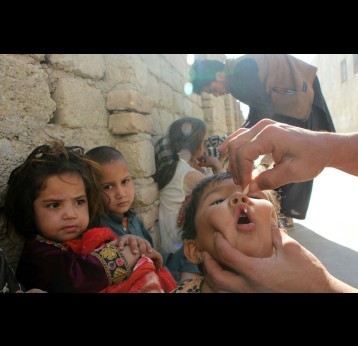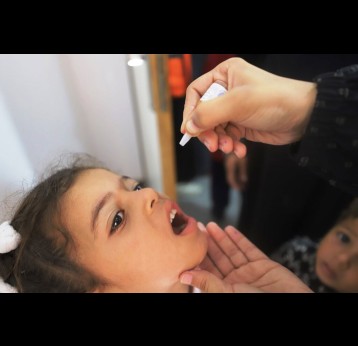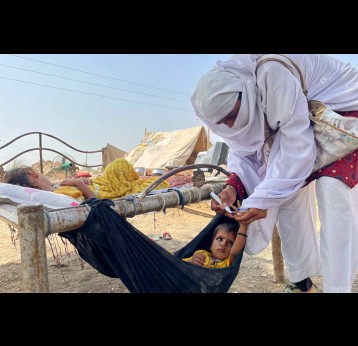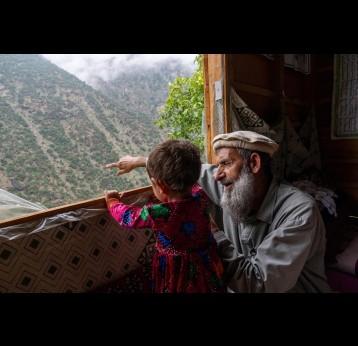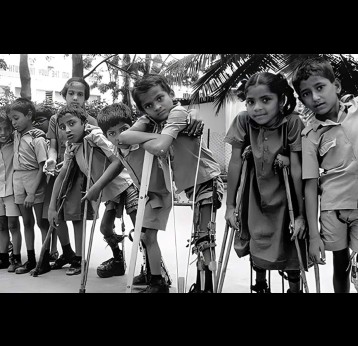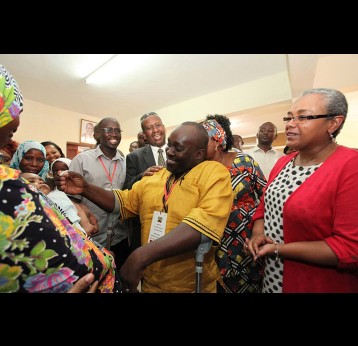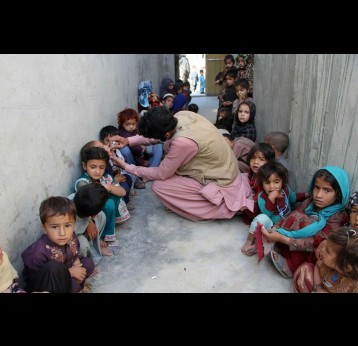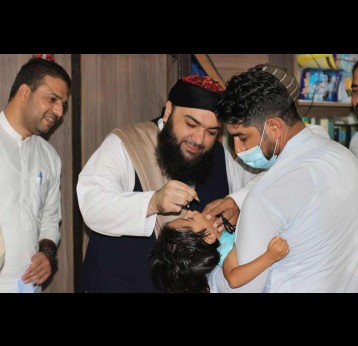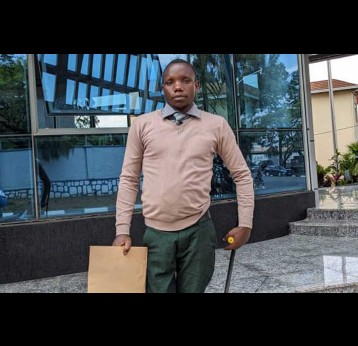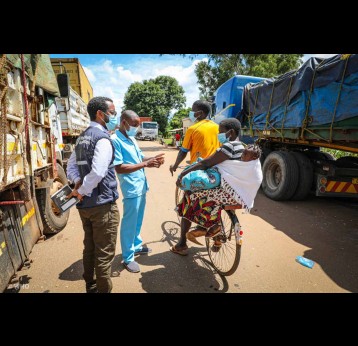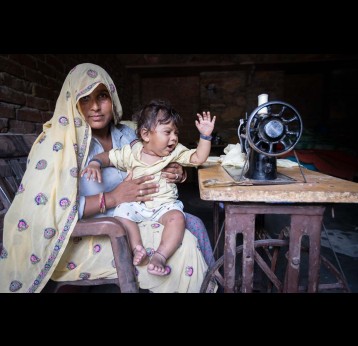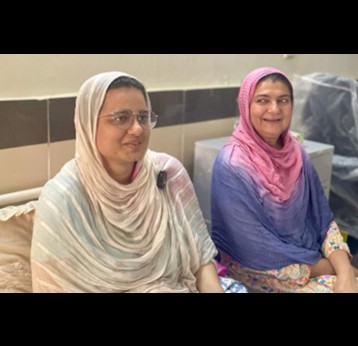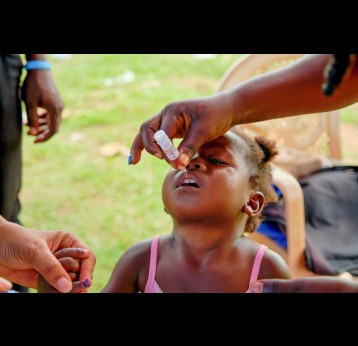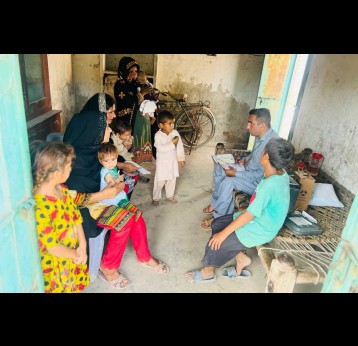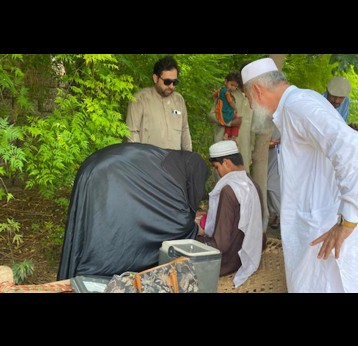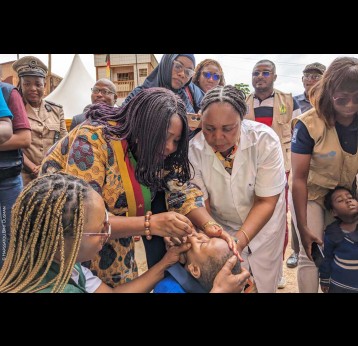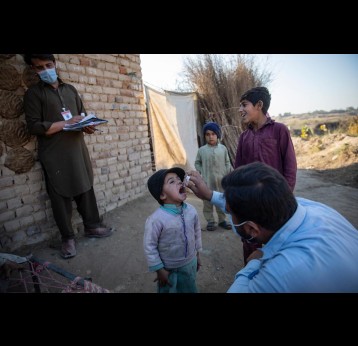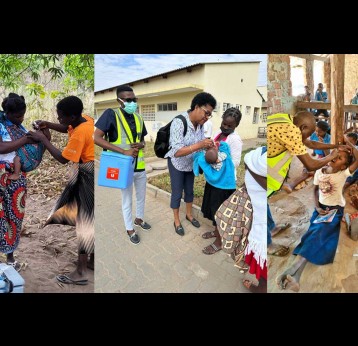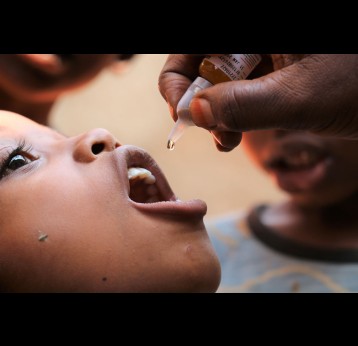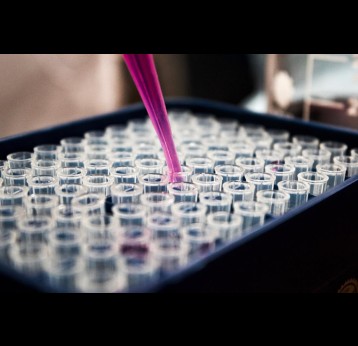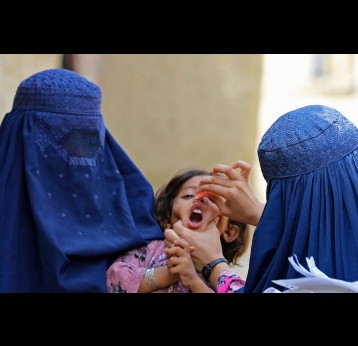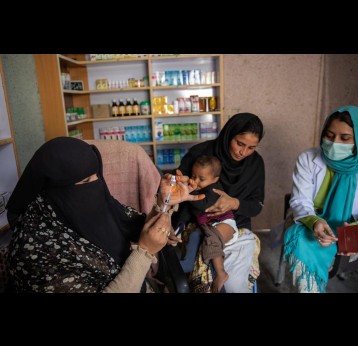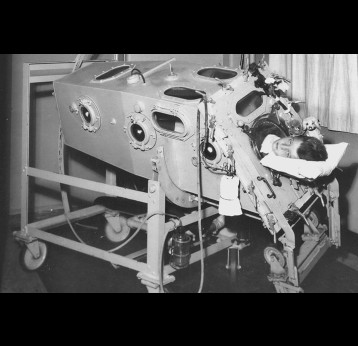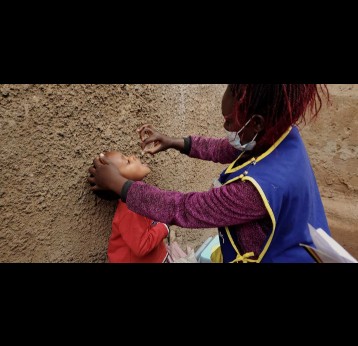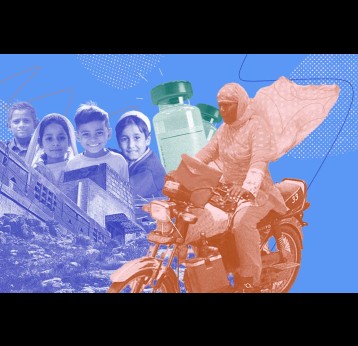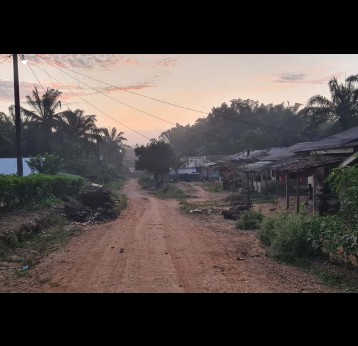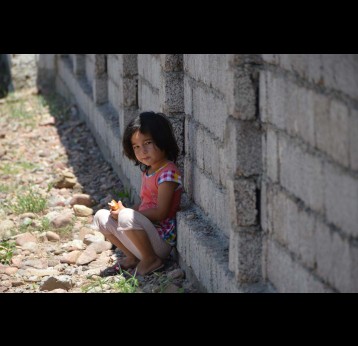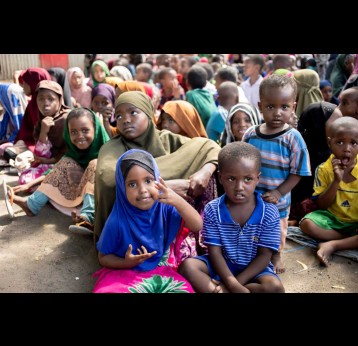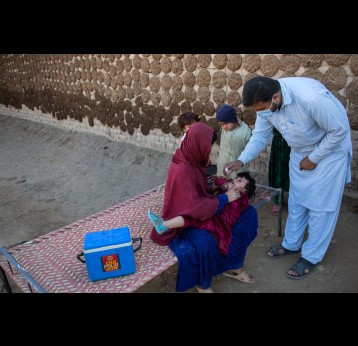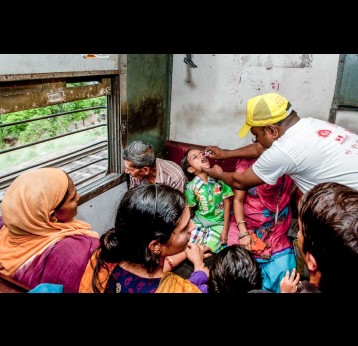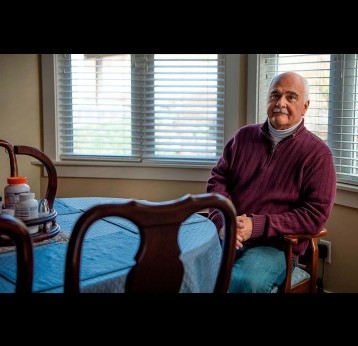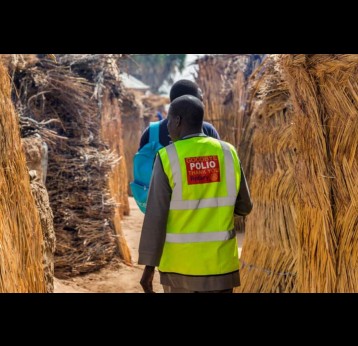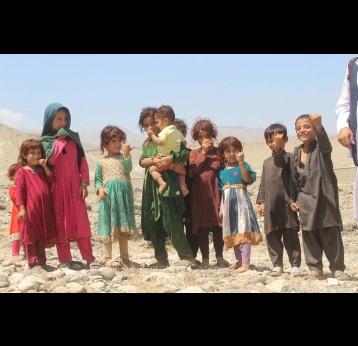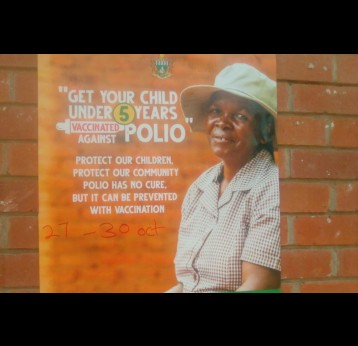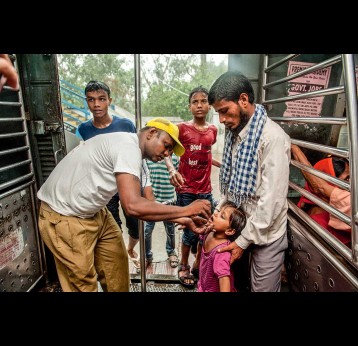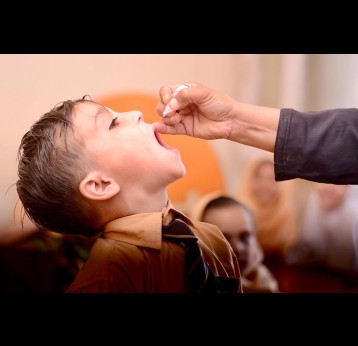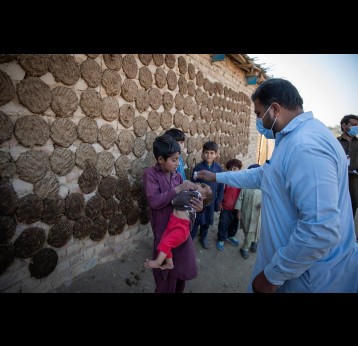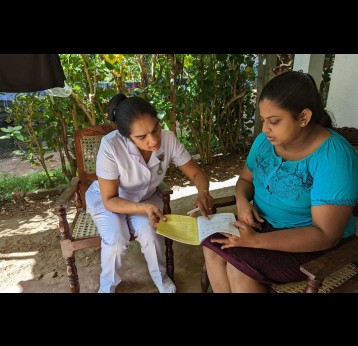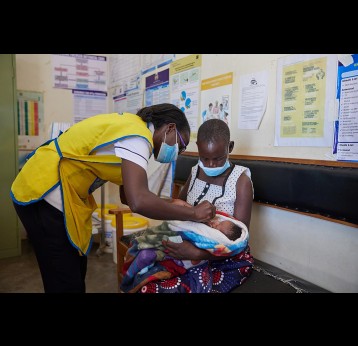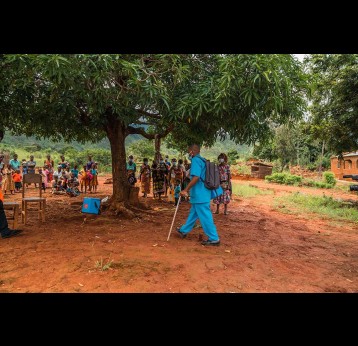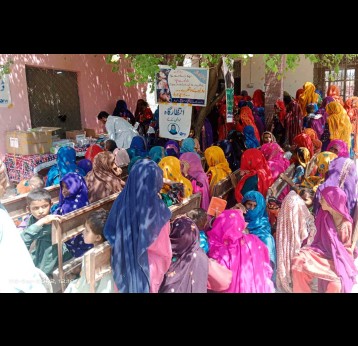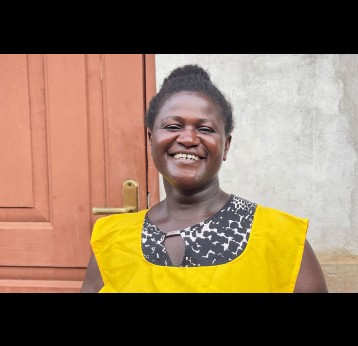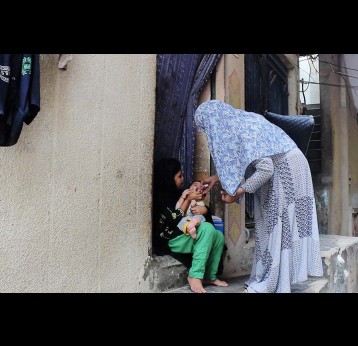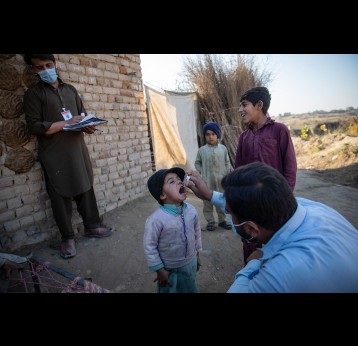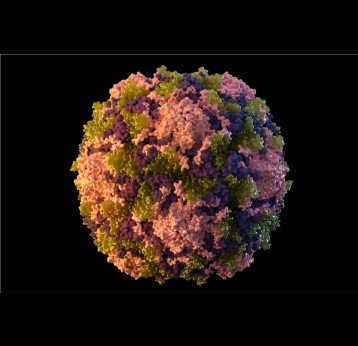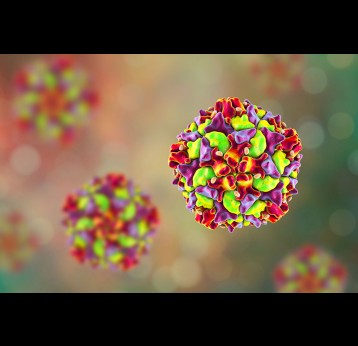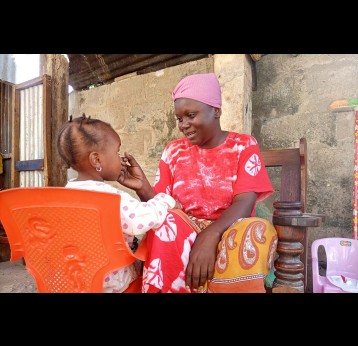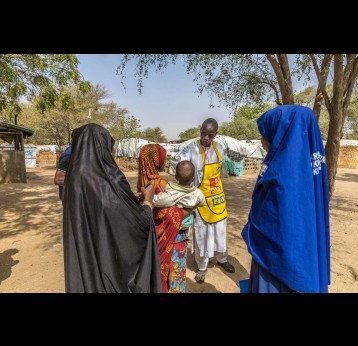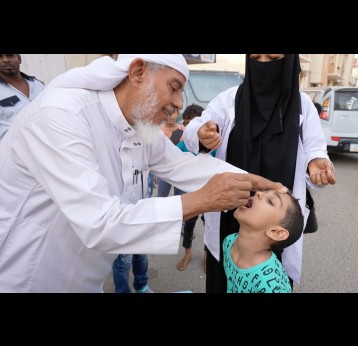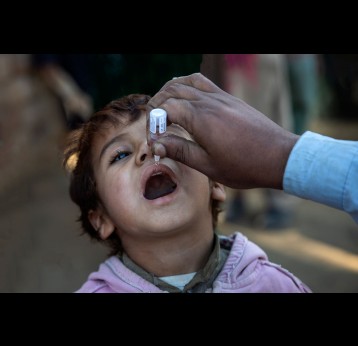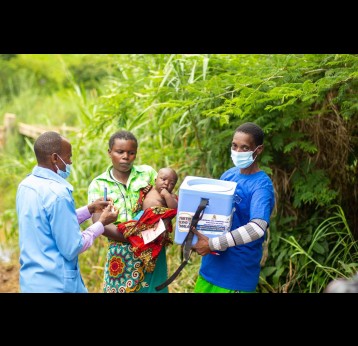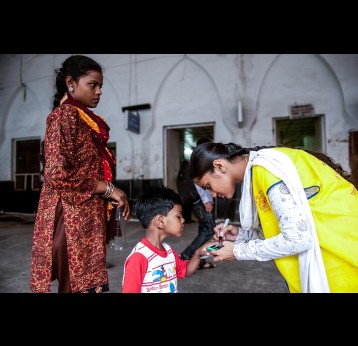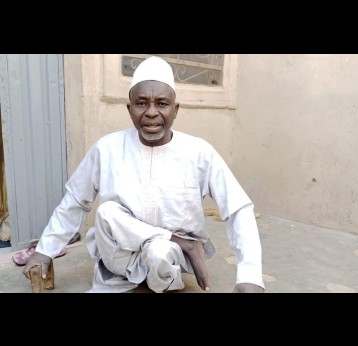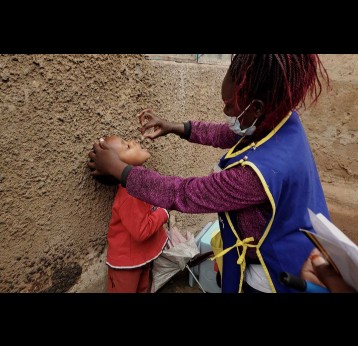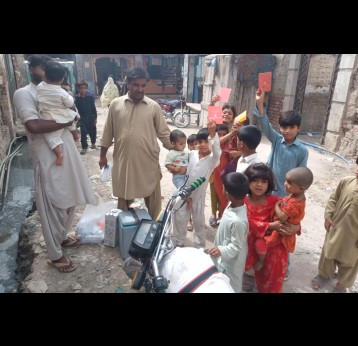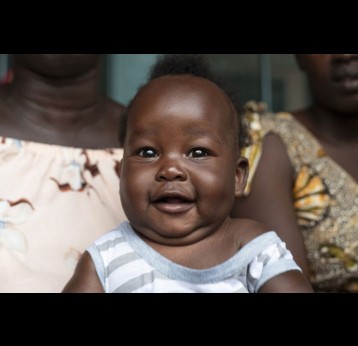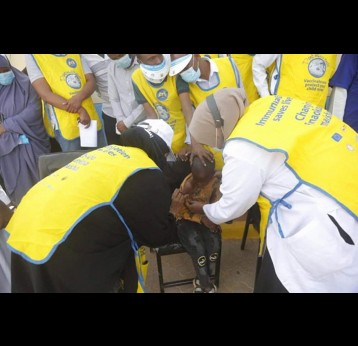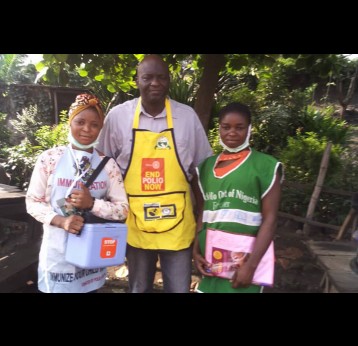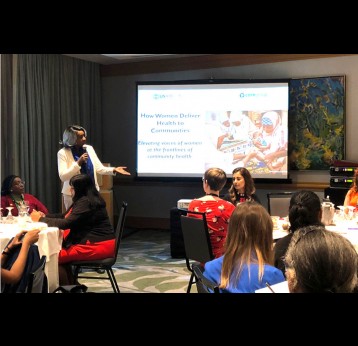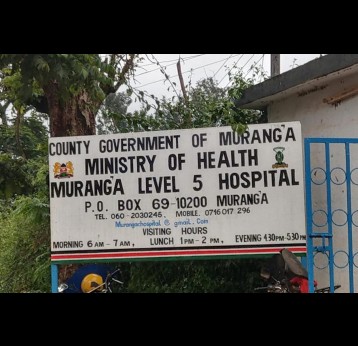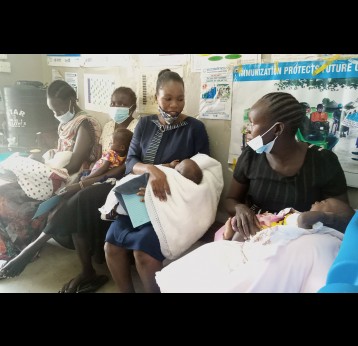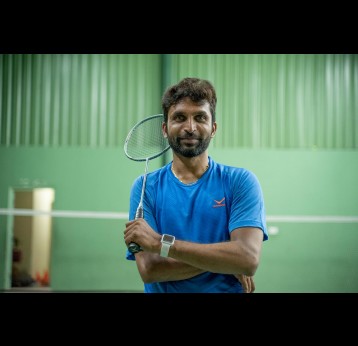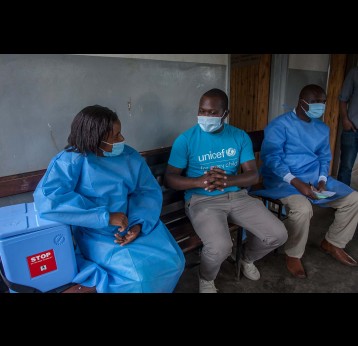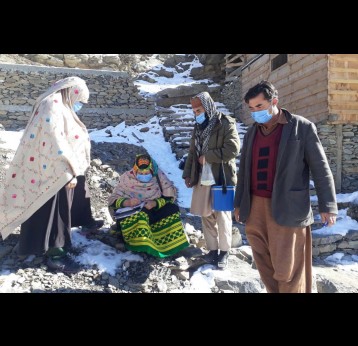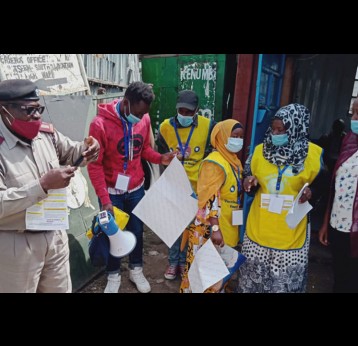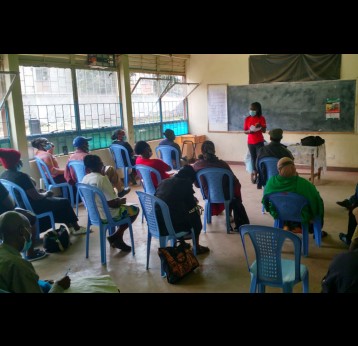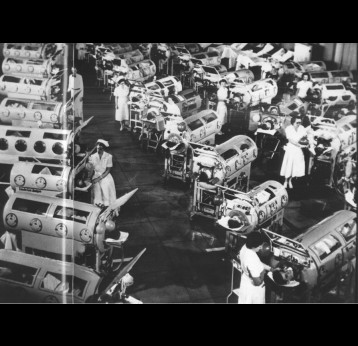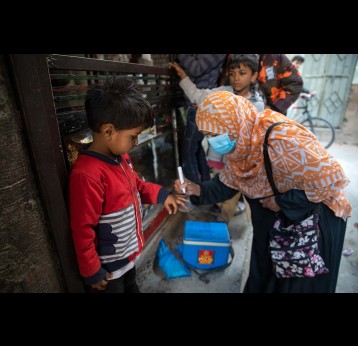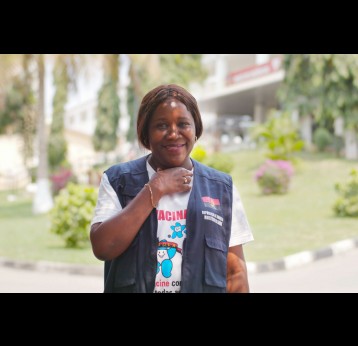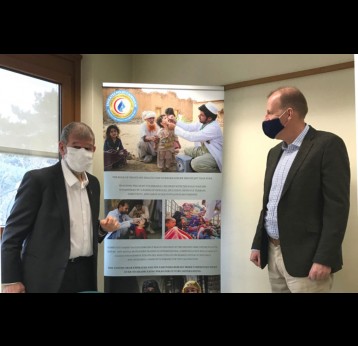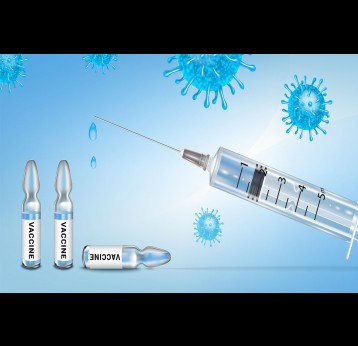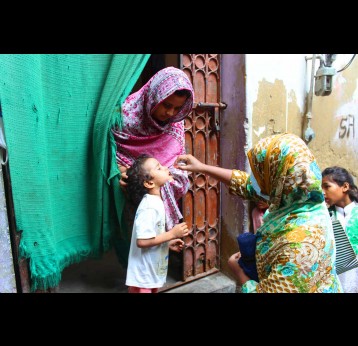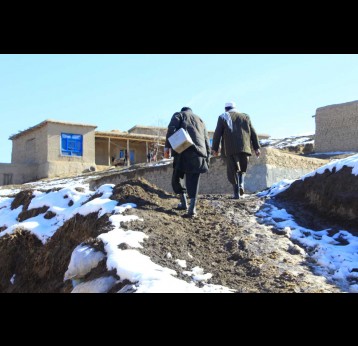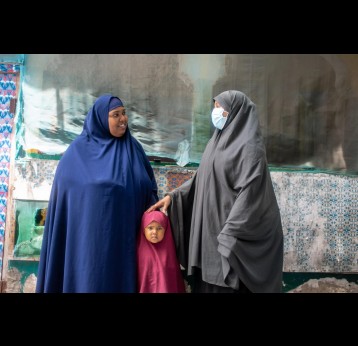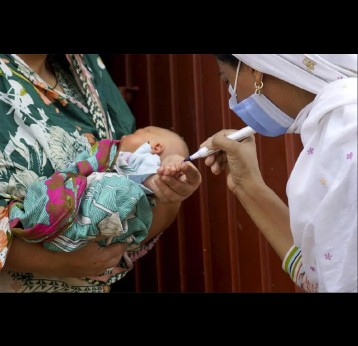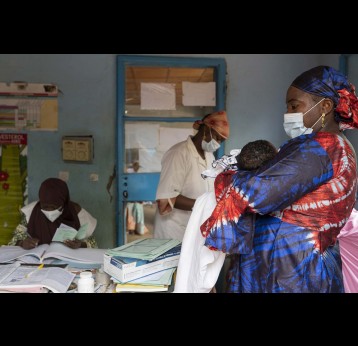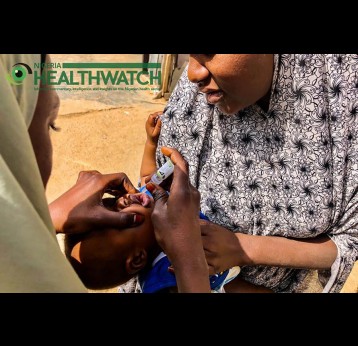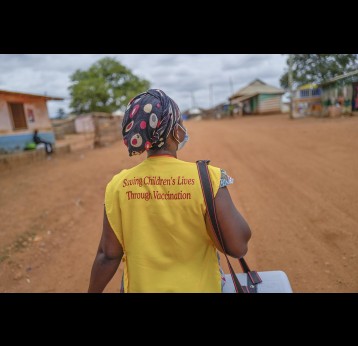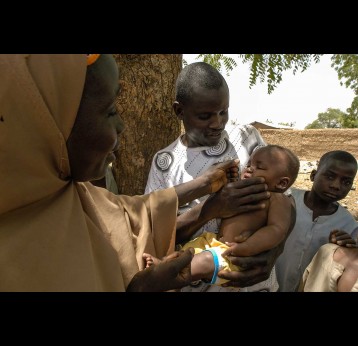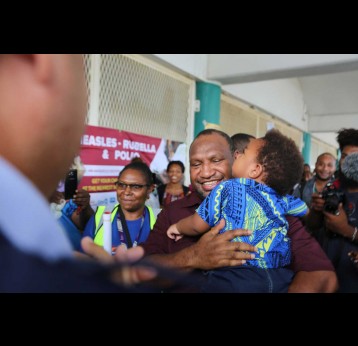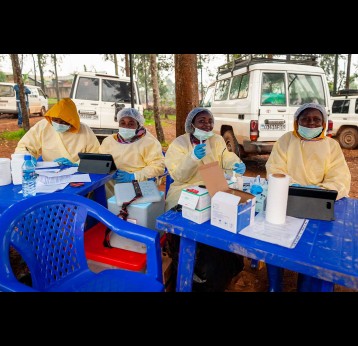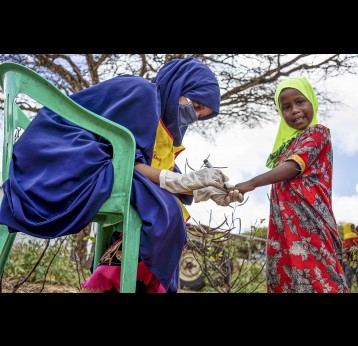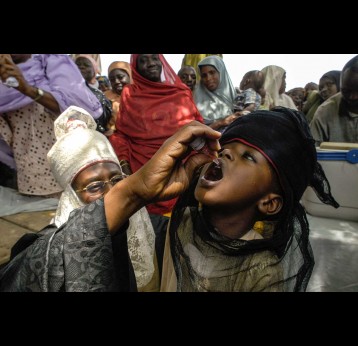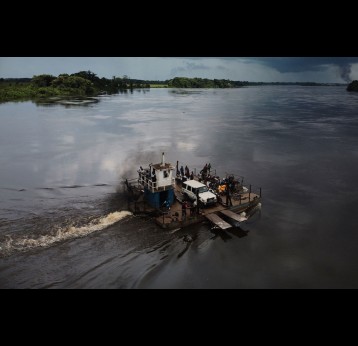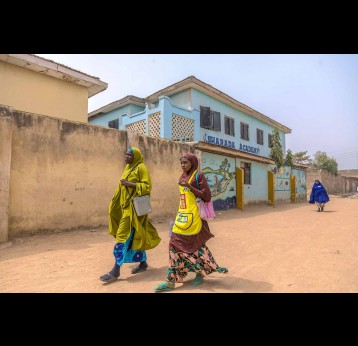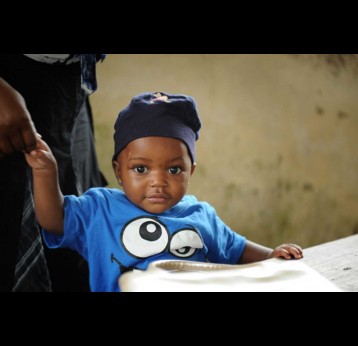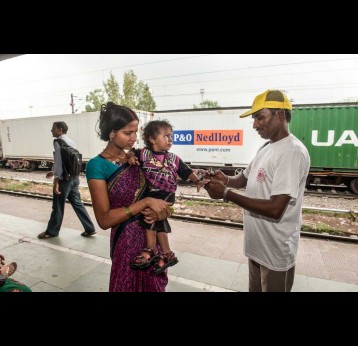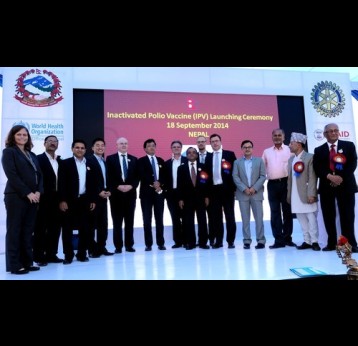Inactivated polio vaccine (IPV) support
Protects against a highly contagious viral infection, mainly affecting children aged under five, which can lead to paralysis or even death.
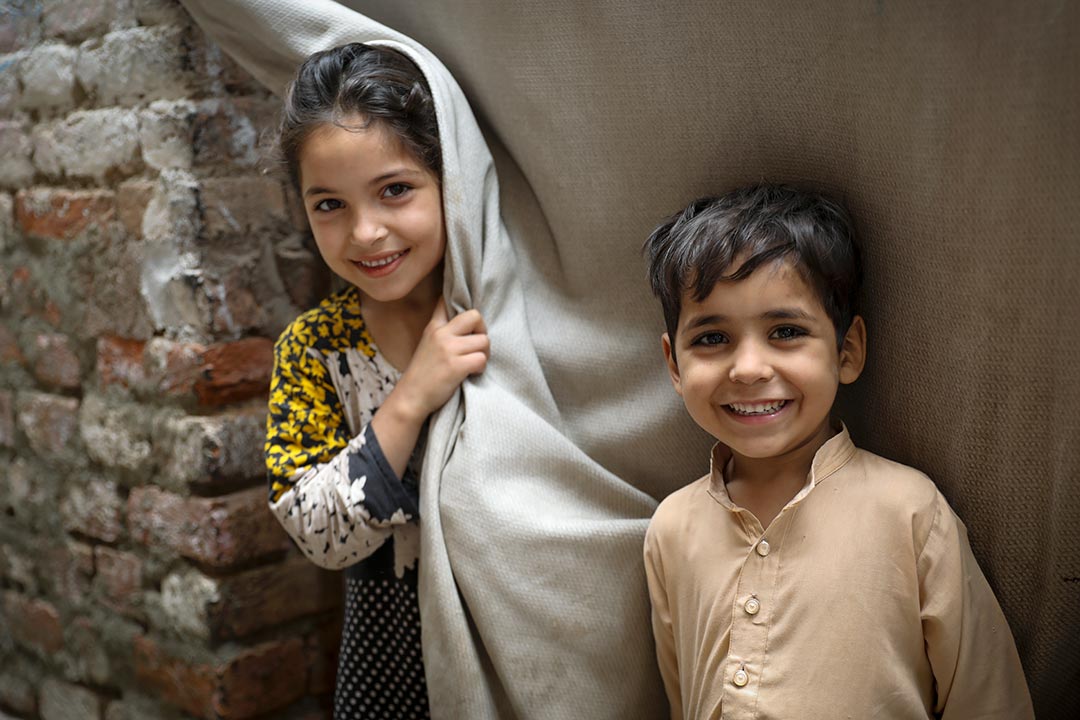
Protects against a highly contagious viral infection, mainly affecting children aged under five, which can lead to paralysis or even death.
Gavi's impact
By 2019, all Gavi-supported countries had introduced the first dose of inactivated polio vaccine (IPV1) into their routine immunisation schedules – reaching a coverage rate of 81% in 2022. All but six countries have implemented catch-up vaccination activities for birth cohorts missed during the period of global supply constraints (2016–2019). The switch from a one-dose schedule to a two-dose schedule (IPV2) is progressing since Gavi's support window for IPV2 opened in 2021: by end 2022, 34 out of 63 eligible countries had switched to a two-dose schedule. The impact of the COVID-19 pandemic, capacity gaps and multiple competing priorities have resulted in delayed introduction for countries already approved to switch to IPV2 – and fewer new applications for IPV2 and IPV catch-up support. Twenty-three countries have not yet applied for IPV2.
The issue
Polio, or poliomyelitis, is a disabling and life-threatening disease caused by the poliovirus. Poliovirus is very contagious and spreads through person-to-person contact. The virus can infect a person's spinal cord, causing paralysis. Paralysis is the most severe symptom associated with poliovirus because it can lead to permanent disability and death.
Gavi supports the Global Polio Eradication Initiative (GPEI) Polio Eradication Strategy 2022–2026 through the introduction of IPV into routine immunisation programmes. When GPEI was launched in 1988, polio was endemic in 125 countries and paralysed about 1,000 children per day. Thanks to global efforts and vaccination, polio cases have fallen by 99% since then. More than 18 million people can walk today who would otherwise have been paralysed, and 1.5 million childhood deaths have been averted because of polio vaccines. Four regions of the world are certified polio-free: the Americas, Europe, South-East Asia and the Western Pacific. Only parts of two countries – Afghanistan and Pakistan – remain polio-endemic. In 2019, Gavi joined GPEI as a full member.
Gavi's response
There are two types of vaccines that can prevent polio:
- inactivated polio vaccine (IPV)
- oral polio vaccine (OPV)
Polio vaccine protects children by preparing their bodies to fight the poliovirus. Almost all children (~99 percent) who get all the recommended doses of IPV will be protected from polio.
The Vaccine Alliance worked with GPEI partners to support one of the fastest roll-outs in the history of immunisation: the introduction of at least one dose of inactivated polio vaccine (IPV) into the routine immunisation schedules of all Gavi-supported countries.
The Strategic Advisory Group of Experts on Immunization (SAGE) recommends that countries catch up children who were missed due to global supply constraints of IPV (2016–2019), as they are currently not protected against poliovirus type 2. All but six countries have implemented catch-up vaccination activities for birth cohorts missed during this period. The Gavi Board has decided to continue support for IPV until global OPV cessation.
Starting 1 December 2023, countries eligible for Gavi support can apply to switch to a whole-cell pertussis (wP) hexavalent vaccine (hexavalent) – a six-in-one vaccine that combines the pentavalent vaccine (diphtheria, tetanus, whole-cell pertussis [DTwP], hepatitis B, and Haemophilus influenzae type b) with IPV. Countries can choose to switch to hexavalent or continue using pentavalent and IPV. Gavi Alliance partners can assist countries to assess the financial, logistical, and programmatic implications of a switch to hexavalent to determine which option is most suitable for their context.
Countries that have not yet introduced IPV2 are encouraged to introduce hexavalent or IPV2 as a matter of urgency. Click here for hexavalent vaccine programme information.
From other sites
From Gavi's 2022 Annual Progress Report:
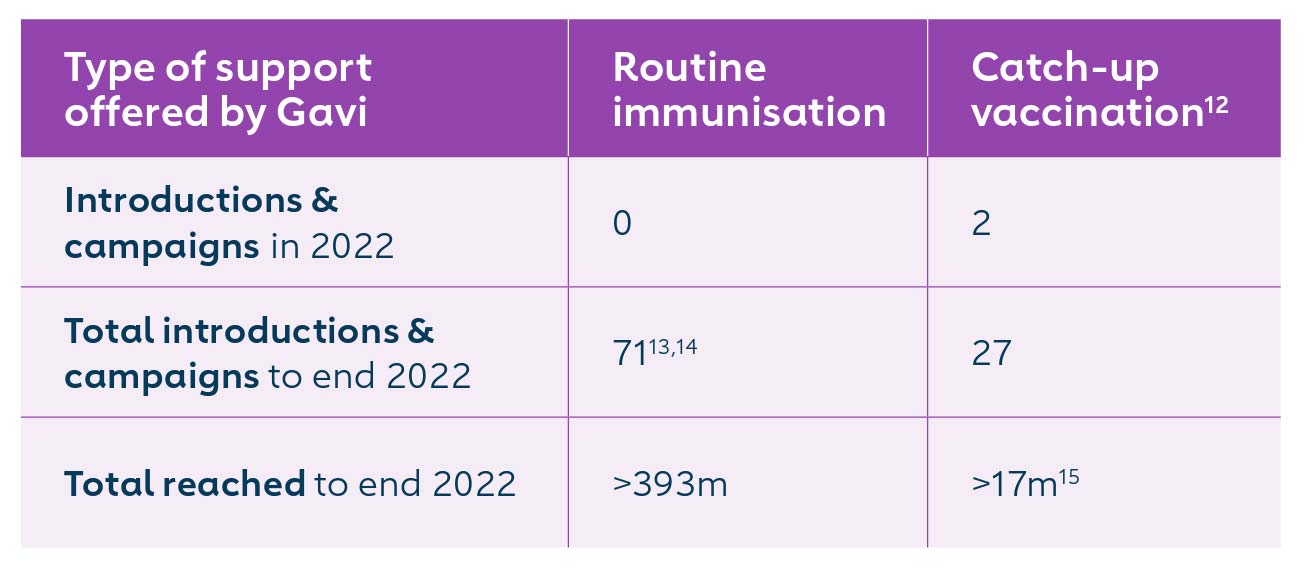
12 IPV catch-up vaccination targets children missed due to the global supply constraints in the period from 2016-2019, and related programme delays and disruptions.
13 All 73 countries have introduced inactivated polio vaccine (IPV), while 34 countries have also switched to using a second dose of inactivated polio vaccine (IPV2). Two of the 73 countries introduced IPV1 independently of Gavi support.
14 IPV is supported by Gavi irrespective of a country's transition status. Indonesia and Viet Nam were fully self-financing at the time of their Gavi-supported IPV introduction.
15 Results are only available for a portion of countries that have completed IPV catch-up to date and will require further analysis.
Latest articles about polio
Malawi is free of the paralysing virus again. What exactly does that mean for the country and for the disease’s young victims?
“Seeing is believing”: how polio survivors are driving immunisation in northern Nigeria
In Sokoto State, Nigeria, a group of polio survivors is turning personal pain into powerful advocacy.
African surveillance labs can power eradication push
National polio laboratories will help Africa in its final push towards eradicating the disease, writes Chikwe Ihekweazu, outgoing acting director for WHO Africa.
High-tech tools, old-school vigilance: how Kenya is keeping polio at bay
Vaccination rid Kenya of wild-type poliovirus over a decade ago, but a lapse in immunisation rates or surveillance now could be incredibly costly, experts explain.
The re-emergence of polio in Papua New Guinea shows global eradication remains elusive
Recent cases of polio in PNG have concerned health authorities. Here’s what to know.
A 'new medical age': 70 years of polio vaccination
12 April marks the 70th anniversary of the world’s first polio vaccine, a world-altering technology.
'Radio Polio': how free radio in Mozambique is helping keep kids safe
Familiar voices speaking local tongues are getting the vaccination message out there, found Winile Ximba in Matola.
Poliovirus found in wastewater in Spain, Germany and Poland – what you need to know
Herd immunity will protect people in those countries for now, but this is a concerning find.
Polio is haunting Gaza as vaccination campaign resumes
If the second vaccine dose is not administered soon, Palestinian children will face yet another threat to life and limb.
Pakistan’s fight to end polio amid the climate crisis
Pakistan, one of the last two endemic countries for wild polio, is closer than ever before to ending this devastating disease for good.
Kano communities turn out in force to mount fresh attack against polio
Babatunde Rolland reports from the frontlines of a polio vaccination drive that aimed to reach more than 20 million children across northern Nigeria.
The legacy of isolation is a double-edged sword for children in Nuristan, Eastern Afghanistan
In Afghanistan’s remote and mountainous Nuristan province, children are highly vulnerable to polio and other deadly diseases due to multiple, intersecting needs that stem from long-standing isolation and multiple deprivations.
Anne Wafula Strike: Polio anywhere is a threat everywhere
Children in Gaza are not only in danger of air strikes, starvation and mental anguish brought on from over a year of war, but also the crippling threat of polio, a disease I contracted at just two years old.
“Just two drops: This is what I didn’t have”: veteran polio activist Harold Kipchumba
Kipchumba, a former nominated Kenyan senator, has spent decades fighting for the vaccine he didn’t get.
Polio: a VaccinesWork briefing
This week, VaccinesWork is shining its spotlight on polio, a disease the world is on the verge of vanquishing. Stay with us to learn about the people, and plans, fuelling that final furlong.
The Taliban suspends polio vaccine campaign in Afghanistan – here's the likely impact
The Taliban says the suspension is temporary and the result of security fears.
In northwestern Pakistan, religious leaders convert the vaccine-hesitant
At a recent ulema conference in Khyber Pakhtunkhwa, 190 renowned Islamic scholars pledged their support for immunisation. Adeel Saeed talked to several of them about the transformative effect they’ve been able to have on community attitudes.
Far from paralysed: Rwandan polio survivors stride towards a safer future
A history of conflict cut off their access to vaccines. Now, marked for life by polio, these young Rwandans have their sights set optimistically on the future.
Keeping gender in mind to stop wild polio in southern Africa
Polio's shock resurgence in Malawi and Mozambique has, after two years, officially been halted. Gender-conscious tactics proved vital - here's how.
Huma Ashraf, an unbroken spirit
The frontline worker who lost her feet in a train accident, but never the resolve to eradicate polio from Pakistan.
Six things you need to know about the latest tool against polio
WHO prequalification of the novel oral polio vaccine type 2 (nOPV2) should make it easier for countries to tackle outbreaks.
Living proof: in Pakistan, a polio-disabled vaccinator inspires his community
Muhammad Kamran lives with the lasting effects of a preventable infection. He’s doing what he can to make sure others won’t have to.
“Reaching the unreached” in one of the last strongholds of poliovirus
In Pakistan’s most polio-troubled region, a new strategy sees encouraging successes.
Cameroon launches new offensive against variant type-2 poliovirus
Being wild polio-free is no guarantee against resurgence, experts caution, as the country battles to repair its vaccine safety net.
Pakistan’s polio and routine immunisation programmes are linking hands. It’s working wonders
Their aims are aligned and their tools are complementary, says Huma Khawar, a health journalist who also works as a CSO coordinator with Pakistan's Expanded Programme on Immunization (EPI).
Stopping an Outbreak in Its Tracks: Polio Response in Mozambique
CDC assists rapid response to a wild poliovirus outbreak in Mozambique.
Burundi fights back against resurgent poliovirus
Round two of a nearly three-million child polio vaccination campaign was launched in mid-August, amid concerns the paralysing virus could still be spreading silently.
New polio detection method could enable faster vaccine responses
A pilot study in the Democratic Republic of Congo suggests the method could roughly halve detection times.
Polio Eradication Through Innovation
Today, the world is closer than ever to eradicating an ancient disease thanks to proven tools and brand-new innovations.
New hexavalent vaccines are coming: What impact could they have?
UNICEF expects WHO prequalification of the first whole-cell pertussis hexavalent vaccine during the third quarter of 2023. Here’s how they differ from existing vaccines.
One world: coming together, to achieve one common goal
Global leaders commit to ending polio once and for all.
Book Excerpt: How the Iron Lung Transformed Polio Care
In 1928, two Americans invented a large metal breathing device that would become synonymous with polio treatment.
After 30 polio-free years, Burundi fights the paralysing virus
An unvaccinated child in Bujumbura Province was the first diagnosed. Since then, 16 cases of acute flaccid paralysis have been found – but vaccines are being deployed.
Polio survivor and international disability rights activist Judy Heumann died this spring at 75. A 2020 documentary portraying her legacy offers important lessons for global health equity.
Motorbike-riding polio worker ruffles feathers and saves lives in rural Pakistan
Amina Khaskheli discovered she can reach more kids on two wheels than on two feet – so that’s what she’s doing. If the sight of her on her bike has upset some conservative onlookers, it has also inspired more than a few young girls.
A broad coalition pulls together to help Indonesia curb polio in its vaccine-shyest province
Aceh is 95% vaccinated against Type 2 polio following a recent shock outbreak, a landmark achievement in the notoriously vaccine-hesitant province.
How Uzbekistan scrambled to stay polio-free – and succeeded
Still endemic to neighbouring Afghanistan, polio was suddenly resurging in next-door Tajikistan. Uzbekistan’s health system needed to act fast, or risk the futures of its children.
“Someone has to do this. And it’s us, here, now”
Rosemary Mukui Nzunza, the head of the Expanded Programme on Immunization (EPI) at the Centre for Virus Research, the Kenya Medical Research Institute, shares her story of pursuing a career in science.
2023 – zero-dose children in seven subnational consequential geographies hold key to success
Polio programme must keep clear focus in 2023 on adapting operations amid broader humanitarian emergencies.
Polio-free India: It seemed impossible until it was done
Dr Hamid Jafari, Director of Polio for the WHO’s Eastern Mediterranean Region, reflects on his time eradicating polio in India and what lessons we can take from this to address the final challenges for achieving eradication in Afghanistan and…
For Some Survivors, Polio Casts a Long Shadow
Decades after the vaccine, adults with post-polio syndrome are struggling with symptoms – and looking for answers.
The peril of polio control in shadow of war
Satellite imagery and deft negotiation are critical tools for polio vaccination teams working across the world’s conflict zones, writes Adeline Tchouakak.
Polio experts eye clear tactics in final push to achieve success
As 2022 draws to a close, independent technical bodies from key epi-centres dive deep on what it will take to achieve success in 2023.
Zimbabwe begins polio drive to quell first threat in 30 years
The country is working with neighbouring countries to vaccinate children under five against polio.
A pediatrician and advocate reveals what’s at stake in the fight for global polio eradication – and why, despite recent setbacks, he refuses to despair.
Pakistan is working with Rotary to eradicate polio
Pakistan is on a mission to get polio back under control following an increase in cases. Rotary International is playing a key role.
The endgame: What will it take to eradicate polio?
Polio cases are down from hundreds of thousands every year in the 1980s to just a few hundred today. We are close to making polio the second human disease to be eradicated, but what will it take to finally consign this killer disease to the…
Keeping communities healthy: Meet the midwives of Sri Lanka
Public health midwives (PHM) are integral to maternal and child health across Sri Lanka.
How to Eradicate Polio? Funds+Vaccines+Access+Equity+Enthusiasm!
As activists, donors and health experts gather in Berlin to raise US$4.8 billion to fund the final push towards polio eradication, Pascal Barollier, Gavi’s Managing Director of Public Engagement and Information Services, gives his view on what’s…
Wild polio returns to Africa: How the GPEI is helping stop an outbreak from becoming an inferno
In February 2022, a year and a half after the continent was declared indigenous wild poliovirus-free, the virus resurfaced in south-eastern Africa. As the Global Polio Eradication Initiative kicks off pledging to fund the 2022-2026 strategy,…
Emergency health camps offer a lifeline to flood-affected families in Pakistan
To stem the potential health risks from the flooding, the government is establishing emergency health camps.
Ghana revives its polio immunisation drive
In September 2022, Ghana completed the first of two four-day national immunisation drives against polio, following the confirmation of two acute flaccid paralysis cases in the country.
Combining health datasets is helping polio vaccination efforts in Pakistan
Pakistan is one of just two countries where the polio virus remains endemic. Challenges remain in identifying and vaccinating all children, but data management software is providing a way forward.
The long tail: Post-Polio Syndrome
Decades after recovering from polio, some survivors are developing progressive muscle weakness and fatigue that can severely impair their quality of life.
What is vaccine-derived polio?
Before the introduction of vaccines, polio killed or paralysed more than half a million people worldwide every year. Since the late 1980s, cases have fallen by 99.9%, due to global efforts to immunise children with the oral polio vaccine. However…
Polio in New York – an infectious disease doctor explains this exceedingly rare occurrence
The oral polio vaccine – which is no longer given in the US – relies on a live but weakened virus that can actually be passed from person to person.
Polio cases have nose-dived by 99% since the late 1980s after a push to eradicate the disease, but clusters of cases across the world indicate that it could resurge if we don’t double down on eradication.
12,000 kilometres towards polio eradication’s last mile
How the Rotarian behind the viral #LondonToLagos motorbike ride crossed continents to remind the world that the road to polio eradication won’t stay open forever.
Tanzania’s polio vaccination drive registers success despite misinformation concerns
To pre-empt a possible outbreak after neighbouring Malawi registered its first polio cases in three decades, Tanzania is going door-to-door to vaccinate its children.
COVID-19 vaccination efforts prove value of polio network for resilient health systems
New report provides evidence on role of polio workforce in COVID-19 vaccine rollout and essential immunization, and makes the case to sustain the network to strengthen public health.
UK polio outbreak: What you need to know
British health officials have declared a national incident after routine surveillance identified potential community transmission of poliovirus in London. Gavi’s Head of Vaccine Programmes, Stephen Sosler, tells Linda Geddes how this can happen…
An Imam promotes the power of vaccines in war torn Yemen
Medical doctors and religious teachers play a crucial role in building trust and convincing families to vaccinate their children against polio.
Funding the Polio Eradication Endgame
The US Centers for Disease Control and Prevention warns that cutting back on eradication efforts could cause a global resurgence of polio that ten years from now could paralyze up to 200,000 children a year. The final five-year push to eradicate…
Malawian polio case prompts mass vaccination campaign
After registering its first polio case in 30 years, Malawi has undertaken a door-to-door vaccination campaign across the country targeting 2.9 million children.
India draws lessons from polio eradication initiative
The programme to eradicate polio shows that mass immunisation is possible in India.
Unsung hero: how a polio survivor is changing the narrative
Polio survivors in Kano State are helping to change perceptions towards vaccines.
Uganda’s door-to-door polio campaign targets unimmunised children
Uganda is working hard to ensure that all the gains made in the fight against polio aren’t lost to the pandemic.
Pakistan reignites polio vaccination drive
Civil society, media, local influencers, celebrities, religious scholars, and frontline workers are all reinforcing the Pakistan government’s fight against Poliomyelitis.
South Sudan committed to polio vaccination campaign in its remote areas
South Sudan has reignited the drive to vaccinate its children against the polio virus.
Delivering essential vaccines in Kenya’s nomadic Gosha community
Kenya is raising awareness about vaccines to reduce the number of zero-dose children who never receiving a single dose.
Teaming up to tackle polio in Lagos
With a recent outbreak of Vaccine-Derived Polio in Lagos and other states in Nigeria caused by poor vaccination coverage, teams are working to ensure that no child is left behind.
Women Leaders in Polio Eradication: Dr. Folake Olayinka
Dr. Folake Olayinka speaks about overcoming gender-related barriers to immunization.
Immunisation relieves the financial burden for families in Kenya
In Kenya, people often rely on their community for assistance in covering medical expenses. Immunisation changes this for the better.
South Sudan’s polio vaccination campaigns are bearing fruit
South Sudan has systematically implemented campaigns to eradicate polio in the country. Hard-working vaccinators are striving to keep it that way.
Anand Kumar: From polio to para-sports world champ
More often than not, the road to a meaningful triumph is a bumpy one.
Over a million children get protected against polio in Malawi
Malawi’s Ministry of Health recently conducted a nationwide polio vaccine catch up campaign targeting 1.8 million children who had previously missed out on the vaccine.
Review: The Cutter Incident by Paul Offit
Offit’s sobering inquiry into “one of the worst biological disasters in American history” is a work of unflinching investigative journalism which lands, finally, not as a whodunit, but as a tribute to modern systems of meticulous vaccine…
“Saving the future of our children”: The women fighting polio in Pakistan
Pakistan is one of two countries where wild poliovirus remains endemic making it essential that the entire country supports the successful implementation of every polio campaign. Women play a critical role, often working at polio’s frontline.
Community Health Workers stop the spread of COVID-19 and polio in Nairobi’s slums
Community health volunteers collaborated with local structures in the slums to help inhabitants survive lockdown and stop the spread of disease.
Kenyans use their polio fighting network to tackle COVID-19
A rich network of community volunteers in Nairobi are putting skills they developed during anti-polio activities to work tackling COVID-19, and mobilising slum dwellers to get the COVID-19 vaccine.
Before 1955, when a vaccine first made polio a preventable illness, the paralysing disease had to be treated. For many, the best option was the iron lung, a device that came to symbolise an era of anxiety in mid-20th century America.
The vaccinators fighting polio in Rawalpindi
In pockets of vaccine resistance like Fauji Colony in Rawalpindi, Pakistan, children remain at risk of crippling polio. VaccinesWork meets the polio workers going door-to-door to change minds and protect children’s futures.
A little less hesitation, a little more action - Elvis and the polio vaccine
As political and public health leaders across the world work to encourage people to get vaccinated against COVID-19, what can they learn from the King of Rock ‘n’ Roll getting jabbed?
Women Leaders in Polio Eradication: Dr. Alda Morais Pedro De Sousa
Dr. De Sousa has spent more than twenty years charting the highs and lows of polio eradication in Angola.
New GPEI Director Aidan O’Leary takes helm of global polio effort
In a special one-off interview, PolioNews (PN) talks to both Aidan O’Leary (A-O’L) and Michel Zaffran (MZ) about the future of polio eradication.
4 of our greatest achievements in vaccine science (that led to COVID vaccines)
We've gone from a novel virus to several COVID-19 vaccines in less than a year. Here's what we've learned from earlier vaccines to allow this to happen.
What it takes to vaccinate 39 million children in Pakistan
Health workers take COVID-19 precautions to deliver polio drops.
Trekking through the snow to deliver vaccines
Vaccinators tackle winter conditions and challenging contexts during Afghanistan’s last polio campaign of the year.
Rallying to vaccinate every child against polio
Community mobilizers inform and prepare communities for vaccinators.
Resumed immunization campaigns are critical to preventing COVID-19 as well as polio
Local adaptation and innovation has allowed the resumption of polio immunization campaigns – and points the way to more effective, community-based delivery of a whole range of basic health services.
Come together: how the fight to end polio can help the COVID-19 recovery
The world is anxiously awaiting the development of a safe and effective COVID-19 vaccine. Nearly 60 years ago, the world was also waiting in eager anticipation of a publicly available vaccine to stop a disease that was ravaging communities around…
Nigeria is polio-free. What next?
Throughout the country, all year-round, routine and supplementary immunisation activities took place to ensure that no child was left behind from being vaccinated.
Ghana launches polio campaigns despite the challenges of COVID-19
In the face of the challenges posed by the pandemic, Ghana is working to protect 4.5 million at-risk children from polio through the launch of two polio vaccination campaigns. Here’s a closer look at those efforts for World Polio Day.
AVADAR: How digital health fast-tracked Nigeria’s drive to eradicate polio
Polio, a contagious disease caused by the poliomyelitis virus is transmitted primarily when stool from someone infected contaminates foods, drinks or water sources. It invades the nervous system and could, in a matter of hours, lead to complete…
The last mile of polio eradication and the vaccination challenges it brings
We are close to a polio-free world, yet cases of vaccine-derived disease are challenging the eradication effort.
Leaders in the fight against infectious diseases
Snapshots from DRC, India and Zambia illustrate country ownership and progress in the fights against Ebola, polio and HPV.
How Somalia is resuming vaccination campaigns despite COVID-19
More than 3,000 health workers are conducting a three-day health campaign from 30 August to 1 September 2020 to ensure that around 400,000 children aged under five receive measles and polio vaccines, as well as vitamin A and deworming tablets, at…
How the African Region is Celebrating the End of Wild Polio while cVDPV Outbreaks Continue
DRC: The great lengths that polio vaccinators go to reach every last child
By foot, boat and bicycle, thousands of volunteer vaccinators in the Democratic Republic of Congo (DRC) go to extraordinary efforts, sometimes at personal risk, to help eradicate polio.
Borno: Africa’s Last Wild Poliovirus Frontier
When Aisha took her son Busami Modu to his grandmother’s house in Kuya, a village in Borno state, Nigeria, she waved goodbye to a healthy, happy little boy. A “beauty to behold,” she recalls. The next time she saw him, he was paralysed and unable…
COVID-19 has triggered lockdown measures for billions of people around the world. As many of us struggle to adapt to the ‘new normal’, we look at the origins of quarantine measures - and how they’ve been used to contain deadly outbreaks for…
From Cameroon – a personal journey to end polio
Interview with David Rizzo, Vaccine Manufacturing Manager at Sanofi Pasteur.
5 steps closer to a polio-free world
The road to polio eradication has been a long one so far, but in 2014, we’re closer than we’ve ever been to getting rid of the disease for good. Here are 5 reasons why.
Pride in polio vaccination: manufacturer witnesses Nepal’s introduction of IPV
Article by Olivier Charmeil, President and CEO of Sanofi Pasteur
